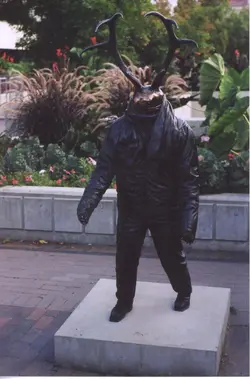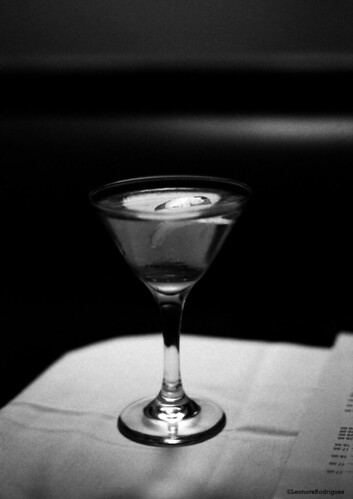Mach2
TPF Noob!
- Joined
- Jul 28, 2014
- Messages
- 30
- Reaction score
- 15
- Location
- Canada, eh?
- Can others edit my Photos
- Photos OK to edit
I'm venturing into all sorts of unfamiliar territory here, and I love it. I was born in '96, so digital cameras were already starting to become popular. I didn't get a camera until I was 11 or so, and even then, it was a crappy little pink point-and-shoot, with every setting automated.
This is my first time shooting with film (that's a lie. I actually shot a full two rolls worth of film, but I'd loaded it into the camera wrong and it didn't advance. Whoops!). This is my first time shooting with manual settings. So that's pretty cool, right?
Anywho! Here are some of the ones I'm proud of. I'd love to hear what everyone thinks of them, and what I can do to get better shots in the future.
1. Statue

I found this statue on the campus of my university. I have no idea what it's supposed to be, but I love it. There's no plaque, no title, no artist credit. He's just there.
2. Fearless

This is my little bro. He likes to skateboard. I told him that if I took him to the skate park, he had to let me take a few pictures.
3. Flowers

The biggest lesson I learned from this roll of film was that, due to my shaky hands, I have to use the fastest shutter speed I can get away with, or prop my camera against something. Otherwise, stuff turns out blurry.
4. Night Life

Taken in downtown Nashville. I wish I'd had time to snap more pictures, but the rest of the group kept on walking, and I didn't want to get left behind. XD
5. Street Art

This one is my favourite. I love street art. Freaking love it. Yarnbombs, graffiti, murals. I was walking home and saw this guy painting, just down the road from me. Not wanting to miss an opportunity, I quickly ran home and grabbed my camera. Then I worked up all my courage to ask if I could take his picture. He said "Sure," and continued painting.
I do wish I'd panned to the left just a tiny bit more, so that his body was closer to the right edge of the frame. But I'm still happy with this one.
All of these were shot with a Pentax K1000, 50mm lens, 400 ISO Kodak film, then scanned and uploaded. There were a few more that I liked on this roll of film, but these were my top 5.
This is my first time shooting with film (that's a lie. I actually shot a full two rolls worth of film, but I'd loaded it into the camera wrong and it didn't advance. Whoops!). This is my first time shooting with manual settings. So that's pretty cool, right?
Anywho! Here are some of the ones I'm proud of. I'd love to hear what everyone thinks of them, and what I can do to get better shots in the future.
1. Statue

I found this statue on the campus of my university. I have no idea what it's supposed to be, but I love it. There's no plaque, no title, no artist credit. He's just there.
2. Fearless

This is my little bro. He likes to skateboard. I told him that if I took him to the skate park, he had to let me take a few pictures.
3. Flowers

The biggest lesson I learned from this roll of film was that, due to my shaky hands, I have to use the fastest shutter speed I can get away with, or prop my camera against something. Otherwise, stuff turns out blurry.
4. Night Life

Taken in downtown Nashville. I wish I'd had time to snap more pictures, but the rest of the group kept on walking, and I didn't want to get left behind. XD
5. Street Art

This one is my favourite. I love street art. Freaking love it. Yarnbombs, graffiti, murals. I was walking home and saw this guy painting, just down the road from me. Not wanting to miss an opportunity, I quickly ran home and grabbed my camera. Then I worked up all my courage to ask if I could take his picture. He said "Sure," and continued painting.
I do wish I'd panned to the left just a tiny bit more, so that his body was closer to the right edge of the frame. But I'm still happy with this one.
All of these were shot with a Pentax K1000, 50mm lens, 400 ISO Kodak film, then scanned and uploaded. There were a few more that I liked on this roll of film, but these were my top 5.







 )
)


![[No title]](/data/xfmg/thumbnail/42/42494-ba608b57b09b00c0ee005a2360a510f5.jpg?1734177014)
![[No title]](/data/xfmg/thumbnail/37/37606-3c9ffb5906173fa2aa489341967e1468.jpg?1734170733)
![[No title]](/data/xfmg/thumbnail/37/37602-1ef8dbb1c2d0e4ff347ee65d328c3603.jpg?1734170730)




![[No title]](/data/xfmg/thumbnail/36/36398-33d875428a7eefdf5b31188ec0f555a5.jpg?1734168784)
![[No title]](/data/xfmg/thumbnail/36/36397-b2aca1c8ba1009853020154d6dd4b0e5.jpg?1734168782)

![[No title]](/data/xfmg/thumbnail/42/42492-60144191c917c21139f8acd72f6ba090.jpg?1734177011)
